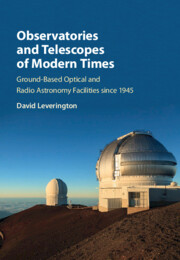 Observatories and Telescopes of Modern Times
Observatories and Telescopes of Modern Times from Part 1 - Optical Observatories
Published online by Cambridge University Press: 15 December 2016
Next Generation Telescope (NGT)
No sooner had the 200 inch (5.0 m) Palomar Telescope been completed in 1948, than some astronomers started to consider whether it would be possible to build an even larger instrument. One of the most determined was Aden Meinel who, in the early 1950s, produced the outline design of an optical reflector of about 500 inch (~12.5 m) diameter. In this the primary mirror was not to be made of one piece of glass, but of several hundred smaller mirrors. But he received little support for his ideas, particularly when the question of funding was raised. It was also not clear at that time whether it was feasible to build such a machine.
Twenty years later, the design of a very large telescope was readdressed by Leo Goldberg the director of KPNO. Telescope design had moved on since Meinel's work, and by 1974 the main building phase of telescopes at KPNO had been completed, leaving a number of talented engineers with relatively little to do.(1) So Goldberg asked these engineers to examine possible designs of an optical telescope with a collecting area equivalent to a 25 m (~1000 inch) diameter mirror.
KPNO's first design concept for this very large telescope, called PALANTIR or rotating shoe telescope, consisted of a 75 m long by 25 m wide segment of the primary mirror which could be rotated in azimuth. This primary was composed of hundreds of polished aluminium segments. The secondary mirror assembly, which included a 3 m secondary mirror, was mounted on the elevation axle, which was parallel to the shortest side of the primary. By moving about this axle, the secondary could view the sky from the zenith down to about 30° above the horizontal. The main advantage of this design, over a conventional one, was that the primary mirror could be rigidly held and did not suffer from variable gravitational forces as the telescope looked at various parts of the sky.
Unfortunately, the proposed resolution of PALANTIR was rather poor, its secondary mirror could only see a fraction of its primary at any one time, and its capital cost of about $160 million was completely out of the question at that time.
To save this book to your Kindle, first ensure [email protected] is added to your Approved Personal Document E-mail List under your Personal Document Settings on the Manage Your Content and Devices page of your Amazon account. Then enter the ‘name’ part of your Kindle email address below. Find out more about saving to your Kindle.
Note you can select to save to either the @free.kindle.com or @kindle.com variations. ‘@free.kindle.com’ emails are free but can only be saved to your device when it is connected to wi-fi. ‘@kindle.com’ emails can be delivered even when you are not connected to wi-fi, but note that service fees apply.
Find out more about the Kindle Personal Document Service.
To save content items to your account, please confirm that you agree to abide by our usage policies. If this is the first time you use this feature, you will be asked to authorise Cambridge Core to connect with your account. Find out more about saving content to Dropbox.
To save content items to your account, please confirm that you agree to abide by our usage policies. If this is the first time you use this feature, you will be asked to authorise Cambridge Core to connect with your account. Find out more about saving content to Google Drive.